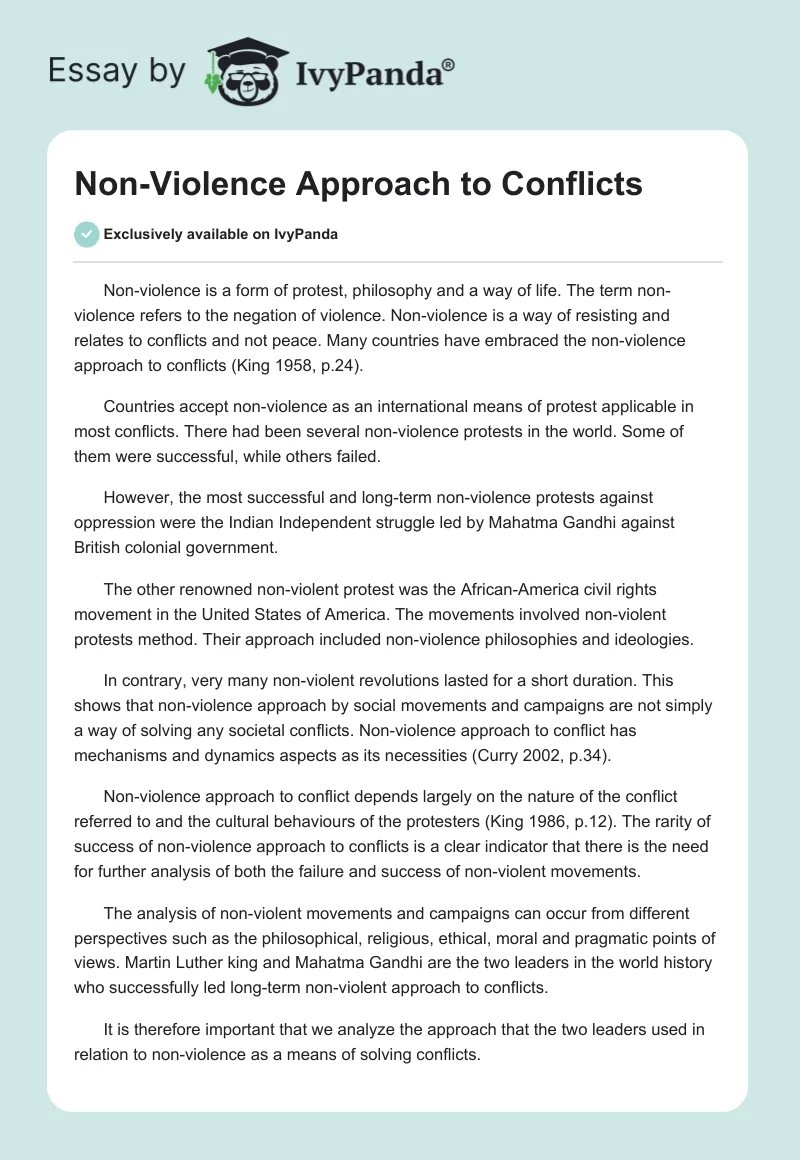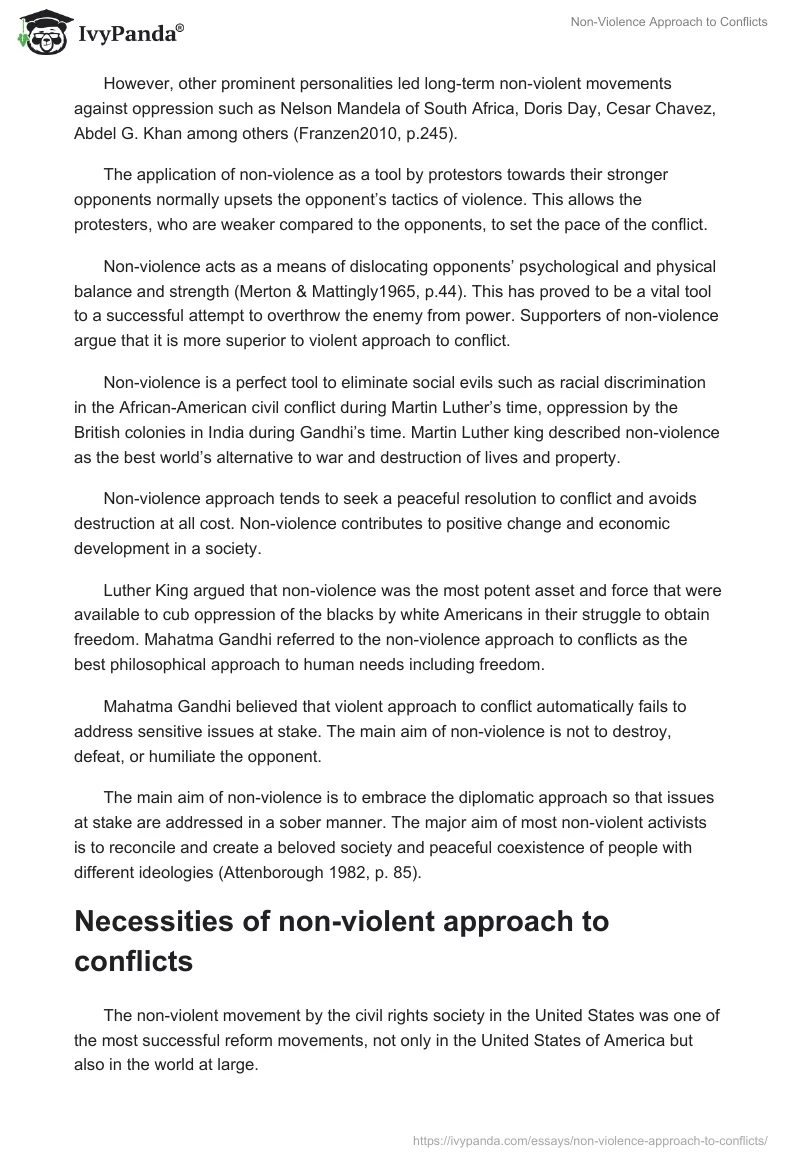Non-violence is a form of protest, philosophy and a way of life. The term non-violence refers to the negation of violence. Non-violence is a way of resisting and relates to conflicts and not peace. Many countries have embraced the non-violence approach to conflicts (King 1958, p.24).
Countries accept non-violence as an international means of protest applicable in most conflicts. There had been several non-violence protests in the world. Some of them were successful, while others failed.
However, the most successful and long-term non-violence protests against oppression were the Indian Independent struggle led by Mahatma Gandhi against British colonial government.
The other renowned non-violent protest was the African-America civil rights movement in the United States of America. The movements involved non-violent protests method. Their approach included non-violence philosophies and ideologies.
In contrary, very many non-violent revolutions lasted for a short duration. This shows that non-violence approach by social movements and campaigns are not simply a way of solving any societal conflicts. Non-violence approach to conflict has mechanisms and dynamics aspects as its necessities (Curry 2002, p.34).
Non-violence approach to conflict depends largely on the nature of the conflict referred to and the cultural behaviours of the protesters (King 1986, p.12). The rarity of success of non-violence approach to conflicts is a clear indicator that there is the need for further analysis of both the failure and success of non-violent movements.
The analysis of non-violent movements and campaigns can occur from different perspectives such as the philosophical, religious, ethical, moral and pragmatic points of views. Martin Luther king and Mahatma Gandhi are the two leaders in the world history who successfully led long-term non-violent approach to conflicts.
It is therefore important that we analyze the approach that the two leaders used in relation to non-violence as a means of solving conflicts.
However, other prominent personalities led long-term non-violent movements against oppression such as Nelson Mandela of South Africa, Doris Day, Cesar Chavez, Abdel G. Khan among others (Franzen2010, p.245).
The application of non-violence as a tool by protestors towards their stronger opponents normally upsets the opponent’s tactics of violence. This allows the protesters, who are weaker compared to the opponents, to set the pace of the conflict.
Non-violence acts as a means of dislocating opponents’ psychological and physical balance and strength (Merton & Mattingly1965, p.44). This has proved to be a vital tool to a successful attempt to overthrow the enemy from power. Supporters of non-violence argue that it is more superior to violent approach to conflict.
Non-violence is a perfect tool to eliminate social evils such as racial discrimination in the African-American civil conflict during Martin Luther’s time, oppression by the British colonies in India during Gandhi’s time. Martin Luther king described non-violence as the best world’s alternative to war and destruction of lives and property.
Non-violence approach tends to seek a peaceful resolution to conflict and avoids destruction at all cost. Non-violence contributes to positive change and economic development in a society.
Luther King argued that non-violence was the most potent asset and force that were available to cub oppression of the blacks by white Americans in their struggle to obtain freedom. Mahatma Gandhi referred to the non-violence approach to conflicts as the best philosophical approach to human needs including freedom.
Mahatma Gandhi believed that violent approach to conflict automatically fails to address sensitive issues at stake. The main aim of non-violence is not to destroy, defeat, or humiliate the opponent.
The main aim of non-violence is to embrace the diplomatic approach so that issues at stake are addressed in a sober manner. The major aim of most non-violent activists is to reconcile and create a beloved society and peaceful coexistence of people with different ideologies (Attenborough 1982, p. 85).
Necessities of non-violent approach to conflicts
The non-violent movement by the civil rights society in the United States was one of the most successful reform movements, not only in the United States of America but also in the world at large.
One of the major necessities of non-violence is its dynamics. Dynamic is the ability of a non-violent protest action or movement to spread to other regions (Forsythe 2000, p.443). Dynamic aspect of non-violence approach to conflict aims at attracting the attention of media and public opinion.
Because of its positive publicity, non-violent movement may draw financial support from donors into the movement or campaigns. If the non-violent protesters do not achieve their aim of mobilizing more people to gain a strong political and financial ground, then the protesters may turn to violence as a desperate attempt to solve the conflict.
For example, political success by civil rights movement in the African-American conflict helped the movement to enjoy a greater legitimacy in 1965.
The success of their non-violent campaigns and protests actions was the decisive factor that enabled the protester in the African-American conflict to negotiate with the federal government of the United States. Another necessity of non-violence is the mechanism of its success.
It is important to note that the survival of a non-violent protest or movement relies on their ability to demonstrate success. Mechanisms of success have a huge psychological influence on the non-violent protesters, media and public opinions, and the longevity of the movement.
For the public and other interested parties to believe in the non-violent movement, the protestors must believe and show the society that it is possible and realistic to succeed in attaining the freedom.
Non-violence would be unnecessary and irresponsible if there was no strong belief that there could be success at the end of the conflict (Carson 2003, p.78).
Conclusion
For any non-violent movement to succeed, the protestors must focus on three major aspects. These include believing in the outcome at the end of the conflict, being able to convince the public to join the movement, and being able to gain both political and financial grounds within the society.
A non-violent movement must advocate and portray to the society that its success is eminent in order to convince more people to join the movement to gain political ground. Once the movement gains the political power, the opponents will have no otherwise but to accept to negotiate terms with the protesters.
Non-violence is the best way of solving conflicts because its aim is not destructive. The property and lives of the protesters are not at risk, as opposed to war and violent way of solving conflicts. Non-violence only affects the psychological mindset of the enemy.
By influencing the public to engage in the movement, the opponents reasoning and power weakens. Non-violent movements have impacts that are more positive to the society compared to violent ways of solving conflicts.
There is assurance concerning the security of community’s resources. There is no reconstruction of infrastructures at the end of the conflict as in the case of violence and civil wars.
References
Attenborough, R. (1982). The words of Gandhi., Newmarket Press: New York
Carson, C. (2003). Reporting civil rights. Literary Classics of the United States: New York.
Curry, D., Mercer, H., & Mattingly, S. (2002). Prisoners of hope: the story of our captivity and freedom in Afghanistan. Doubleday: New York.
Forsythe, D. P. (2000). The United States and human rights: looking inward and outward. University of Nebraska Press: Lincoln.
Franzen, J. (2010). Freedom. Farrar, Straus and Giroux: New York.
King, M. L. (1958). Stride toward freedom: the Montgomery story. Harper: New York.
King, M. L., & Washington, J. M. (1986). A testament of hope: the essential writings of Martin Luther King, Jr.. Harper & Row: San Francisco.
Merton, T. (1965). Gandhi on non-violence. New Directions Pub. Corp: New York.


